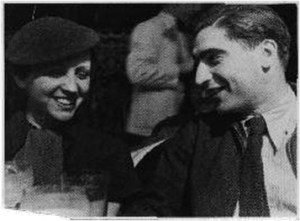Visualizing the war in Spain
This article appeared in the 36th issue of the newsletter of the International Brigade Memorial Trust and is reprinted here with the IBMT’s permission.

COVER PHOTO:Gerda Taro and Robert Capa in Paris in 1935. Fred Stein’s photo of the two young photographers who would soon go to Spain is on the cover of Jane Rogoyska’s illustrated biography of Taro.
Her reputation as a ground-breaking war photographer long overshadowed by that of Robert Capa, Gerda Taro is the focus of a new book* that powerfully asserts the importance of her work in the Spanish Civil War, writes Jim Jump.
Author Jane Rogoyska describes how Gerda Pohorylles, a young Jewish émigrée from Germany, met and fell in love with the Hungarian André Friedmann, another Jewish exile from fascism in Paris. They rein- vented themselves as Gerda Taro and Robert Capa, penniless but politically committed photographers.
Taro was just 26 when she was killed on 25 July 1937 during the Battle of Brunete. Capa was heartbroken. Though her funeral in Paris saw thousands of mourners throng the streets and she became an instant hero of the left, her memory and legacy were soon forgotten. Capa, however, became a legend for his work in Spain – and also in China and the Second World War.
Then, 70 years later, came the discovery in Mexico City of the “Mexican Suitcase”. It contained thousands of negatives of photos taken in Spain by Taro, Capa and colleague David Seymour (“Chim”). Among them was a cache of previously unseen pictures taken by Taro at Brunete. But, most astonishingly of all, the newly discovered archive showed that many photographs that had been attributed to Capa were, in fact, the work of Taro.
Richly illustrated with Taro’s photos from Spain, including many rare ones, Rogoyska’s book tells the story of Taro’s short life and demonstrates her influence in shaping not just the way we visualise the war in Spain but the nature of war photography itself.
*“Gerda Taro: Inventing Robert Capa” by Jane Rogoyska (Jonathan Cape, London, 2013) £35 (hardback).
Jane Rogoyska was one of the speakers at the 2014 IBMT Len Crome Memorial Lecture in Manchester on 1 March.












